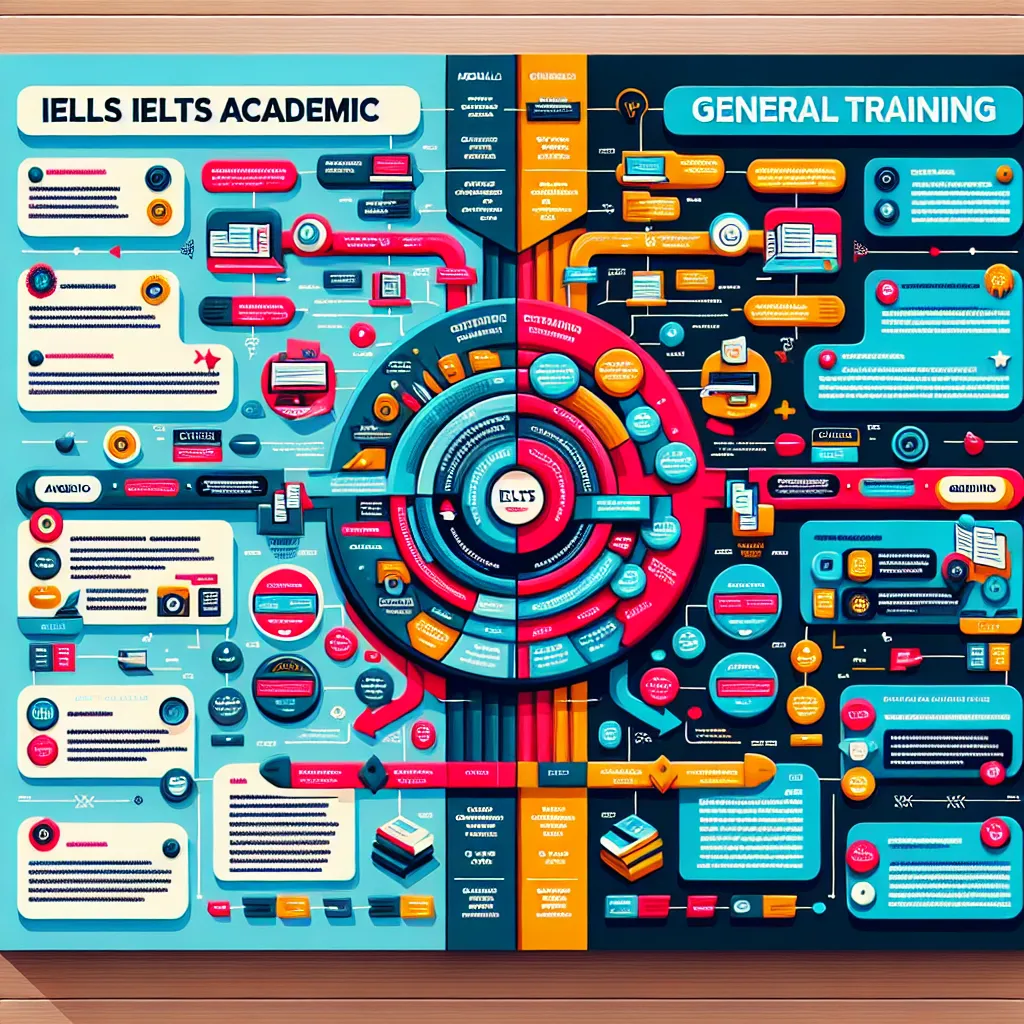Are you preparing for the IELTS exam but unsure which module to choose? Understanding the difference between IELTS Academic and General Training modules is crucial for your success. This comprehensive guide will walk you through the key distinctions, helping you make an informed decision and tailor your preparation accordingly.
Introduction to IELTS Modules
The International English Language Testing System (IELTS) is designed to assess the language ability of candidates who need to study or work where English is the language of communication. It offers two main test formats: Academic and General Training.

Purpose and Target Audience
IELTS Academic
The IELTS Academic module is primarily for those planning to study at undergraduate or postgraduate levels, or for professional registration purposes. It assesses whether a candidate is ready to begin studying or training in an environment where English is the language of communication.
Target audience:
- University applicants (undergraduate and postgraduate)
- Professionals seeking registration in English-speaking countries (e.g., doctors, nurses, pharmacists)
- Those seeking high-level professional positions in business environments
IELTS General Training
The IELTS General Training module is suitable for those planning to undertake non-academic training or work experience, or for immigration purposes to English-speaking countries.
Target audience:
- Immigration applicants to Australia, Canada, New Zealand, and the UK
- Those seeking work experience or training programs in English-speaking environments
- Secondary education and work-based training
Test Format and Structure
Both IELTS Academic and General Training tests consist of four sections: Listening, Reading, Writing, and Speaking. The Listening and Speaking sections are identical for both modules, while the Reading and Writing sections differ.
Listening (40 minutes)
Both modules feature the same Listening test, which includes:
- Four recorded monologues and conversations
- 40 questions
- A variety of question types (e.g., multiple choice, matching, plan/map/diagram labelling)
Reading (60 minutes)
IELTS Academic Reading
- Three long texts from books, journals, magazines, and newspapers
- Texts are authentic and may include graphs, diagrams, or illustrations
- 40 questions testing various reading skills
IELTS General Training Reading
- Three sections of increasing difficulty
- Section 1: Short texts related to everyday life
- Section 2: Work-related texts
- Section 3: Longer, more complex text on a general topic
- 40 questions in total
Writing (60 minutes)
IELTS Academic Writing
- Task 1: Describe visual information (graph, table, chart, or diagram) in your own words (150 words, 20 minutes)
- Task 2: Write an essay in response to a point of view, argument, or problem (250 words, 40 minutes)
IELTS General Training Writing
- Task 1: Write a letter requesting information or explaining a situation (150 words, 20 minutes)
- Task 2: Write an essay in response to a point of view, argument, or problem (250 words, 40 minutes)
Speaking (11-14 minutes)
The Speaking test is the same for both modules and consists of three parts:
- Part 1: Introduction and interview (4-5 minutes)
- Part 2: Individual long turn (3-4 minutes)
- Part 3: Two-way discussion (4-5 minutes)
Key Differences in Content and Difficulty
Reading Section
The main difference lies in the content and complexity of the texts:
- Academic: More challenging vocabulary, abstract concepts, and academic topics
- General Training: More straightforward language, everyday topics, and work-related content
Writing Section
Task 1 differs significantly:
- Academic: Analyze and describe visual information
- General Training: Write a letter for various purposes
Task 2 is similar in both modules but may have slightly different expectations:
- Academic: More formal style, may require more analytical thinking
- General Training: Can be slightly less formal, often relates to everyday issues
Scoring and Results
Both modules use the same 9-band scoring system for each section and the overall score. However, the interpretation of scores may differ:
- Academic: Higher scores often required for university admissions
- General Training: Score requirements may vary depending on immigration or employment criteria
How to Choose the Right Module
Consider the following factors when deciding between Academic and General Training:
- Purpose of taking the test (study, work, or immigration)
- Requirements of your target institution or organization
- Your personal strengths and weaknesses in English
- Your familiarity with academic or professional English
Preparation Strategies
For Academic Module
- Practice reading academic journals and scientific articles
- Improve your skills in describing graphs and charts
- Develop your essay writing skills with a focus on formal academic style
For General Training Module
- Read newspapers, magazines, and general interest books
- Practice writing different types of letters
- Focus on everyday vocabulary and practical communication skills
Common Mistakes to Avoid
- Choosing the wrong module for your needs
- Underestimating the differences in the Reading and Writing sections
- Neglecting to practice specific skills required for your chosen module
- Focusing too much on one section at the expense of others
Next Steps
Now that you understand the differences between IELTS Academic and General Training modules:
- Confirm which module you need with your target institution or organization
- Take a diagnostic test to assess your current level
- Create a study plan focusing on your chosen module
- Practice regularly using authentic materials and sample tests
- Consider enrolling in a preparation course or working with a tutor
Remember, success in IELTS comes from consistent practice and familiarity with the test format. Whether you choose Academic or General Training, dedicate time to improving your English skills across all four sections.
By understanding the key differences between IELTS Academic and General Training modules, you can now make an informed decision and tailor your preparation effectively. Good luck with your IELTS journey!